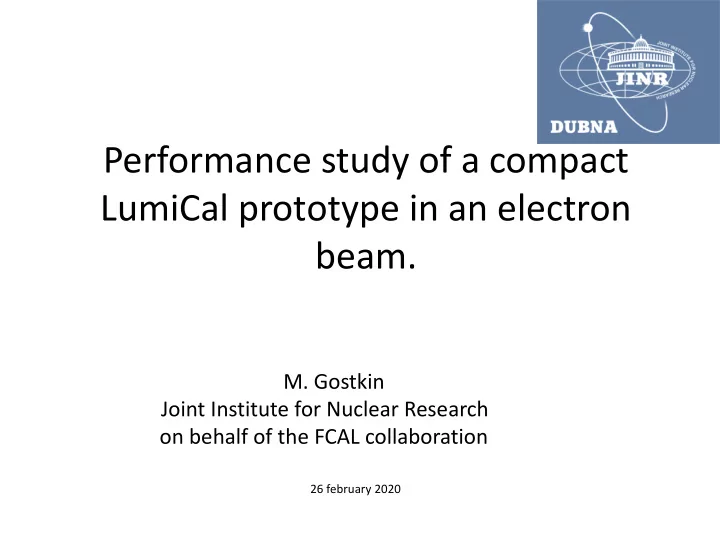

Performance study of a compact LumiCal prototype in an electron beam. М. Gostkin Joint Institute for Nuclear Research on behalf of the FCAL collaboration 26 february 2020
54 members from 14 institutes : AGH University of science & technology, Krakow, Poland CERN, Geneva, Switzerland DESY, Germany IFJ PAN, PL-31342, Krakow, Poland ISS, Bucharest, Romania JINR, Dubna, Russia National Research Tomsk State University NI TSU, TSU / Russia NC PHEP, Belarusian State University, Minsk, Belarus Pontificia Universidad Catolica de Chile, Santiago, Chile Taras Shevchenko National University of Kiyv, Ukraine Tel Aviv University, Tel Aviv, Israel Tohoku University, Sendai, Japan University of California, Santa Cruz, USA Vinca Institute of Nuclear Sciences, University of Belgrade, Serbia We are grateful to the support of the BMBF-JINR program for detector R&D. FCAL is supported by national funding agencies and programs of the European Community. 2
R&D for special calorimeters in the very forward region of future detectors at an e+e- collider. ILC CLIC - compact, - precise shower position measurement FCC-ee - read out very fast - radiation hardness CEPC
LumiCal and BeamCal in future e+e- accelerators LumiCal provide: • precise determination of the integrated luminosity by measuring the rate of Bhabha events at low angles. BeamCal: • device for fast, bunch-by-bunch crossing luminosity using beamstrahlung. Radiation hardness is an issue. LumiCal and BeamCal: • improving the hermeticity of the detector by providing electron and photon identification down to polar angles of a few mrad. • to extend calorimetric coverage to small polar angles. Important for physics analysis.
LumiCal and BeamCal – electromagnetic sampling calorimeters • The technology of a Semiconductor-Tungsten sandwich calorimeter is under investigation: Sensors for the LumiCal - Si; for the BeamCal GaAs or sapphire. • layers of 140x140x3.5 mm (1 X_0) thick tungsten plates with 1 mm gap for silicon sensors (30 for ILC, 40 for CLIC) • Good flatness ~30 µm were achieved Zeiss 3D coordinate measurement system
LumiCal sensor • Silicon sensor, 320 m m thickness • 64 radial pads, pitch 1.8 mm • 4 azimuthal sectors in one tile, each 7.5 degrees • 12 tiles make full azimuthal coverage • p+ implants in n-type bulk • DC coupled with readout electronics • 40 modules were produced by Hamamatsu
Detector plane assembly total thickness 650 μ m
LumiCal test at DESY in 2016 • DESY-II Synchrotron electron beam 1-5 GeV (beam size 5x5 mm2) • T1, T2 - Eudet telescopes each with 3 MIMOSA Si-pixel planes • Sc1,2,3 - scintillator trigger • Tg - copper target • Dipole magnet – 13 kGs for e/ γ separation • 8 detector planes (6 -LumiCal, 2-tracker), 256 read-out channels • 8 W absorber plates • External electronics (ASD-based)
Shower position measurement Resolution of (440 ± 20) m m is found Eur.Phys.J. C79 (2019) no.7, 579
Shower development transverse Longitudinal Good agreement between data and MC (within Effective Moliere radius : statistical uncertainties) 8.1 ± 0.1 (stat) ± 0.3 (syst) mm
Shower profiles and effective Moliere radius The Moliere radius is independent of the beam energy. Why we see an dependence is due to the limited fraction of the shower accessible in this analysis.
LumiCal test at DESY in 2019
Experimental set-up The ALPIDE chip measures 15x30 mm and includes a matrix of 512x1024 pixel cells LumiCal plane consist of 256 pads, during the test beam only 128pads were read-out using an APV-25 board 3 million events acquired in LumiCal Work is ongoing on analysing November 2019 test beam data
New readout FLAME JINST 10 (2015) P11012 JINST 10 (2015) P12015 FLAME: project of 32-channel readout ASIC in CMOS 130nm, front- end&ADC in each channel, fast serialization and data transmission, all functionalities in a single ASIC Chip and front end board produced. Will equip the 2020 test beam.
Conclusion • A prototype of a compact calorimeter is studied in electron beams. • The measurement of the longitudinal and transverse shower size is in very good agreement with simulations. • The effective Moliere radius is obtained to be 8.1 ± 0.1 (stat) ± 0.3 (syst) mm and the resolution of the shower position reconstruction (440 ± 20) m m . • This is indeed a 'highly compact' calorimeter, with the Moliere radius at the feasible limit. • March 2020: LumiCal test beam with 20 assembled layers Close to final front end electronics + readout and DAQ, based on FPGA.
Backup
Luminosity at e + e - collider Bhabha scattering at low polar angles is used e + e - e + e - ( g ) L = N / s Count From Bhabha theory events 17
Recommend
More recommend